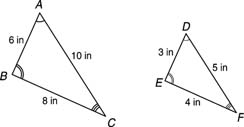Let us learn about Regular Polygons,
There is really no limit to the number of sides a polygon may have. The only practical limit is that unless you draw them on a very large sheet of paper, after about 20 sides or so, the polygon begins to look very much like a circle.
Parts of a regular polygon
In a regular polygon, there is one point in its interior that is equidistant from its vertices. This point is called the center of the regular polygon. In Figure 1, O is the center of the regular polygon.
The radius of a regular polygon is a segment that goes from the center to any vertex of the regular polygon.
The apothem of a regular polygon is any segment that goes from the center and is perpendicular to one of the polygon's sides. In Figure 1 , OC is a radius and OX is an apothem.
Because a regular polygon is equilateral, to find its perimeter you need to know only the length of one of its sides and multiply that by the number of sides. Using n-gon to represent a polygon with n sides, and s as the length of each side, produces the following formula.
There is really no limit to the number of sides a polygon may have. The only practical limit is that unless you draw them on a very large sheet of paper, after about 20 sides or so, the polygon begins to look very much like a circle.
Parts of a regular polygon
In a regular polygon, there is one point in its interior that is equidistant from its vertices. This point is called the center of the regular polygon. In Figure 1, O is the center of the regular polygon.
| |||
| |||
The radius of a regular polygon is a segment that goes from the center to any vertex of the regular polygon.
The apothem of a regular polygon is any segment that goes from the center and is perpendicular to one of the polygon's sides. In Figure 1 , OC is a radius and OX is an apothem.
Finding the Perimeter
Because a regular polygon is equilateral, to find its perimeter you need to know only the length of one of its sides and multiply that by the number of sides. Using n-gon to represent a polygon with n sides, and s as the length of each side, produces the following formula.




 , usually expressed in reduced form. An alternative form involves a colon. The colon form is most frequently used when comparing three or more numbers to each other. See Table
, usually expressed in reduced form. An alternative form involves a colon. The colon form is most frequently used when comparing three or more numbers to each other. See Table 



